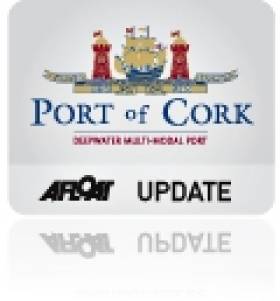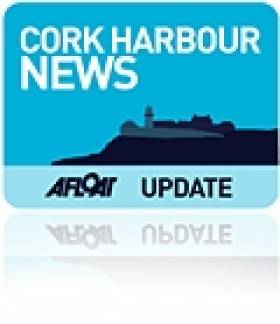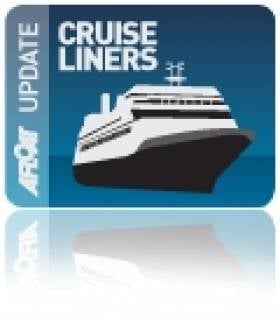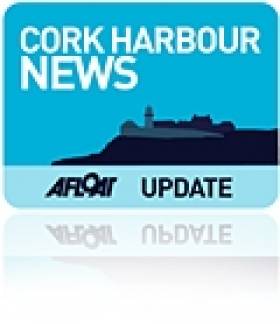Displaying items by tag: port of Cork
Port of Cork Opens its Doors for Heritage Day
On Saturday 28th August 2010, the Port of Cork will open its doors to the public from 11am until 4pm as part of Cork Heritage Day. The spectacular rooms of Custom House will be open to the public offering visitors the opportunity to view the impressive boardroom and committee room as well as the fine collection of maritime artwork owned by the Port of Cork Company.
With the new Port of Cork City Marina in place, the Port of Cork is encouraging boat owners to use the facility for Cork Heritage Day.
Commercial Manager Michael McCarthy said; 'The Pork of Cork are delighted to open Custom House once again to the public and what better way to arrive in the city than by water. We are encouraging all boat owners if they are planning on visiting the city for Heritage Day to use the Port of Cork City Marina, which allows excellent access to all the city attractions.'
The Port of Cork City Marina is free to use during the day, however overnight charges do apply. It is advisable to pre-book a berth if planning on visiting the city by boat for Cork Heritage Day. To request a berth please visit www.portofcork.ie
Event to Showcase Cork Harbour
Cork Harbour Open Day will take place on Saturday 4th September 2010 and already there are a number of free events planned to take place around the harbour.
To name but a few, Cork City will host the World Rescue Challenge on the Port of Cork's North Custom House Quay, Cobh will host the start of the annual Cobh to Blackrock Sailing race, while in Crosshaven there will be farmers markets, rowing championships and the RNLI Station will be open to the public.
It is expected that many more events will be announced in the coming days. For a full programme please visit www.corkharbour.ie
Aimed at embracing what Cork Harbour has to offer, the Cork Harbour Open Day aims to raise awareness of the different activities available for people in the harbour both on and off the water.
The idea for a Harbour Open Day emerged from discussions between various stakeholders involved in the development and implementation of the Integrated Strategy for the Harbour. A group comprising representatives from UCC, City and County Councils and the Port of Cork set about working together to engage users of the Harbour and to organise the Open Day.
Cork Harbour is the second largest natural harbour in the world, next to Sydney Harbour, offering beautiful locations for enjoying the outdoors, dramatic coastlines, and excellent leisure facilities.
To get involved in Cork Harbour Open Day or to organise an event on the day, please visit www.corkharbour.ie or contact Sara Dymond at [email protected] or 021-4625375.
Dublin and Cork Share Cruise-Calls Bonanza
The ports of Dublin and Cork are scheduled to receive a record 139 cruiseships in total this year, bringing 180,000 visitors and crew. Many more of these cruiseships are due to visit over the next two months and stretching into late Autumn. Between €35-55m is expected to be generated into the Dublin region from high-spend cruise visitors
while a further €5m is predicted for the local economy at Cork, writes Jehan Ashmore.
A notable visitor due to grace Dublin Bay is the return of The World, albeit not strictly a cruiseship but the first custom-built time-share ship. The vessel is to dock in the capital for four-nights from 4-8 August and then sails overnight to Cobh, for two-nights from 9-11 August.
In essence, The World presents an exclusively unique lifestyle experience. Instead of passengers, there are 'residents' who live onboard. Residents of the 43,188 gross tonnes (GT) vessel don't merely occupy a cabin but own large-sized luxurously appointed private apartments that are 'home' complete with balconies.
On 9 August, Silver Cloud docks at Dublin from Oban, Scotland. Measuring 16,927 GT, the vessel may not be the largest with only 315 passengers, but is an ultra-luxury cruiseship, regarded as one of the highest standards in the cruise-sector industry.
Returning to Cork Harbour, Cobh awaits the mighty Independence of the Seas. At 154,407 tonnes, she is the biggest ever cruiseship to dock at any Irish port. With a massive 4,375 passenger capacity, attractions include rock-climbing or surfing-boarding using a special pool. The 'Independence' berths mid-afternoon on 29 August for an overnight call, departing 18.00hrs the next day.
Among smaller cruiseships, the private-motoryacht like, Island Sky of 4,000 tonnes and with 200 passengers, calls to Dublin on 11 August, and may berth upriver close to the new Samual Beckett Bridge.
Those keen on traditional ships, can look forward to the visit of Classic International Cruises Princess Danae, built in 1955. The veteran is due 16 August, and her sister, Princess Daphne is expected 2 September. Unusually the 16,000 tonnes pair were converted from general cargo-ships for a career in cruising.
New cruiseship, Costa Luminosa (92,700 GT) costing US $ 548m makes a second call to Cobh on 3 September and is operated by Costa Cruises.
This is the first time the Italian company has ventured into Irish cruising waters.
Without doubt the largest Dublin caller this season will be Emerald Princess. The giant weighs some 113,000 gross tonnes and at 288m long will certainly provide a spectacle, with lights blaring over a dozen or so decks, during a dusk departure on 14 September.
Also entering service this year, P&O Cruises 116,000 tonnes new Azura, is set to visit Dublin on 23 September and Cork the next day. The Italian built newbuild cost US $ 535m and has a capacity for 3,076 passengers.
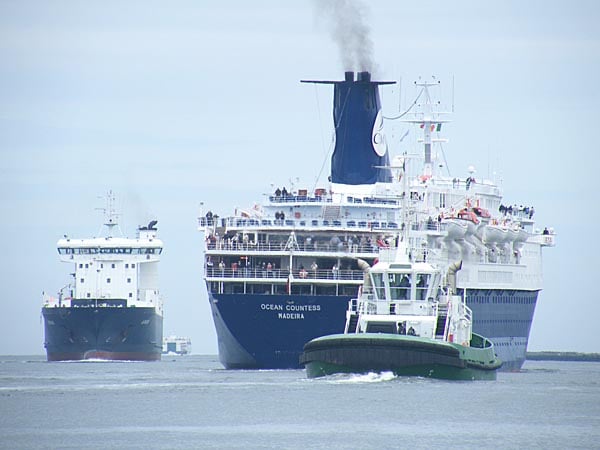
Ocean Countess departing Dublin. Photo: Jehan Ashmore/ShipSNAPS
A newcomer to Irish ports is Cruise & Maritime Voyages Ocean Countess which is making round Ireland itineraries with calls at Cobh on 13 August and 12 September. Incidently the 'Countess' was converted into a troopship for the Falkland Islands conflict in 1982.
Jewel of the Seas (90,090 GT) makes a Cobh call on 7 September and exactly a month later returns, marking the last cruise-call to Cork in 2010 while Fred Olsen's Boudicca will be Dublin's last caller on 20 November.
For further information on other visiting cruiseships, please click links:
Port of Cork Selects Ringaskiddy as Terminal Site
Port of Cork announced yesterday a site in Ringaskiddy in Cork Harbour would be the most suitable site for the development of its shipping container business. The new site will by adjacent to the existing ferry terminal. A full report is in today's Irish Times by Barry Roche here.


























